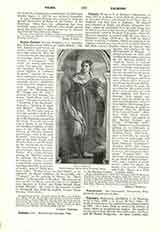

Palma Vecchio (JACOPO NIGRETI), b. at Serinalta near Bergamo, about 1480; d. at Venice, July 30, 1528. Like Giorgione and Lotto, he studied under Giovanni Bellini, from whom he drew the inspiration for his altar-pieces, introducing, however, more freedom of arrangement. His works are strong and broad rather than graceful. Imitating Giorgione, Palma treated sacred subjects as “tableaux de genre”, wherein the sometimes exuberant strength, animation, and limpid, transparent coloring deserve admiration while they lack religious sentiment. Among these productions are: the “Madonna with St. George and St. Lucy”, painted for San Stefano, Vicenza; “Saint Peter with six saints” (Accademia of Venice); “Adoration of the Shepherds” (Louvre); “Meeting of Jacob and Rachel” (Dresden Museum). His favorite subjects were the so-called “Holy Conversations”, i.e., the Holy Family or the Madonna surrounded by saints. Examples are to be seen at Rome, in the Colonna and Borghese Galleries, at Florence, in the Uffizi and Pitti Palaces, at Dresden, Munich, and Vienna. One of his most beautiful “conversations” is that of the Holy Family with St. John Baptist and St. Lucy, in the Accademia of Venice. His master-piece is the altar-piece in Santa Maria Formosa, Venice. It is a triptych representing St. Barbara between St. Anthony the Hermit and St. Sebastian. Palma was also a remarkable portrait painter, excelling especially in portraits of women, most of whom were court ladies. Worthy of note are: the “Bella”, in the collection of Baron Alphonse de Rothschild; the “Violante”, in the museum of Vienna; the “Three Sisters”, in the museum of Dresden. His portraits of men are also excellent, especially that of an unknown man (museum of Berlin), and Palma himself (Pina-cothek, Munich). He received the surname Vecchio to distinguish him from his nephew, Jacopo Palma Palmer Giovane (1544-1628).
GASTON SORTAIS

